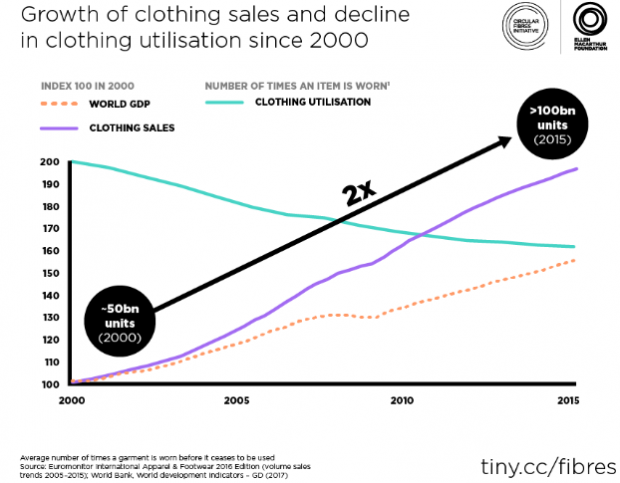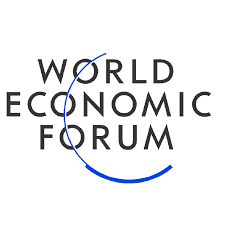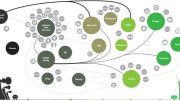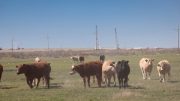Young people around the world are working to clean up a dirty fashion industry.
The $2 trillion industry is responsible for 10% of the global carbon footprint, negative environmental effects including water pollution, the use of toxic chemicals and high levels of textile waste, and poor working conditions for millions of workers, primarily women.
The World Economic Forum’s Global Shapers community is taking a grassroots approach to address these issues on local and regional levels while promoting a global dialogue about how to encourage sustainable transformations in the industry.
“Fashion, as an overarching term for the apparel, footwear and textiles sector, is a huge global industry that touches us all (physically!) and employs millions of people,” says Holly Syrett, 32, a Global Shaper in the Amsterdam Hub. “But it is simultaneously a very dirty business that has long hidden how it works.”

Image: Ellen MacArthur Foundation
This year more than 30 Global Shaper hubs worldwide are participating in Shaping Fashion, an initiative that organizes activities and projects during Fashion Revolution Week to raise awareness of the sustainability challenges of the fashion industry and empower local communities to pursue sustainable fashion solutions. The projects include clothing swaps, film screenings and roundtables – each designed to meet the local community’s needs and inspire sustainable fashion efforts year-round, says Syrett, who is a co-founder of the initiative.
For example, the Amsterdam Hub in the Netherlands is bringing together two groups, Sustainable Apparel Coalition and Fashion for Good, to discuss the importance of transparency in the fashion industry with members of the local community.
“It’s important that we demand to know more about the brands that we buy from, the products that we buy and the circumstances under which they are made,” Syrett says. “Only with access to this kind of information will we be able to choose more sustainable products that meet our personal values and by doing so, reward the brands that create them.”
The Lusaka Hub in Zambia is organizing a thrift market to promote the consumption of second-hand clothing and a panel discussion to examine what sustainable fashion looks like in Africa. There is opportunity for the African fashion industry to draw from lessons around the world but also form a unique approach to sustainable fashion that honors each local community’s cultural heritage, says Sekayi Fundafunda, 29, a Global Shaper in the Lusaka Hub.
“Slow fashion, its part of our heritage,” she says. “The question today is: How can we build futuristic business that draw inspirations from that history?”
The Davao Hub in the Philippines is hosting a fashion and sustainability fair called Unstitch, which will feature workshops, talks and a pop-up shop filled with sustainable fashion brands. The idea is to create a conversation focused on how fashion affects Davao, says Yana Santiago, 27, a Global Shaper in the hub and co-head of the project.
“When people in Davao hear about the fashion revolution, it’s in the UK, so it’s not relatable,” she says. “We’re identifying and addressing the local problems, such as cultural sustainability. We’re inviting local tribes to tell us their stories and share their struggles.”
In the Dallas Hub in the US, the focus is on upcycling workshops to share the benefits of reusing materials and efforts like the Clean Clothes Campaign to improve working conditions in the garment industry.
“More and more people are getting aware of the issues with fast fashion and are looking into alternatives,” says Faye Francisco, 24, a Global Shaper from the Dallas Hub. “Dallas is a really big shopping hub, and there’s so much potential for the impact to be huge.”
The Joinville Hub in Brazil is partnering with University Uniasselvi to hold presentations on the economical aspects of sustainable and ethical fashion, a screening of the documentary “The True Cost,” and a clothing-swap event. Sustainable fashion is particularly important to Brazil, which is the fourth-largest textile and denim producer in the world and faces many of the negative effects of the fashion industry, including toxic materials entering the water supply and low-paid workers, says Livia Rudolph, 31, a Global Shaper from the Joinville Hub.
“Sustainable fashion should be the only way for our country,” she says. “I would like to see more cooperation across industries for research and development of sustainable practices, upstream and downstream cooperation to implement these practices, and more information and education available to orient consumers.”
The movement to promote sustainable fashion can also start on a personal level, says Simge Sandal, 29, a Global Shaper from the Dusseldorf Hub. Shaping Fashion suggest five steps for people who want to take part in the movement.
5 ways to promote sustainable fashion
- Step 1: Ask #whomademyclothes – demand more transparency from your favorite brand
- Step 2: Assess Your Closet – know and treasure what you own
- Step 3: Wash Smart – wash cool, use eco-detergent, air dry
- Step 4: Upcycle, Repair and Share – make each piece last
- Step 5: Shop Less and Buy Well – when you buy, buy second-hand, ethical, organic and only items you love and that will last





